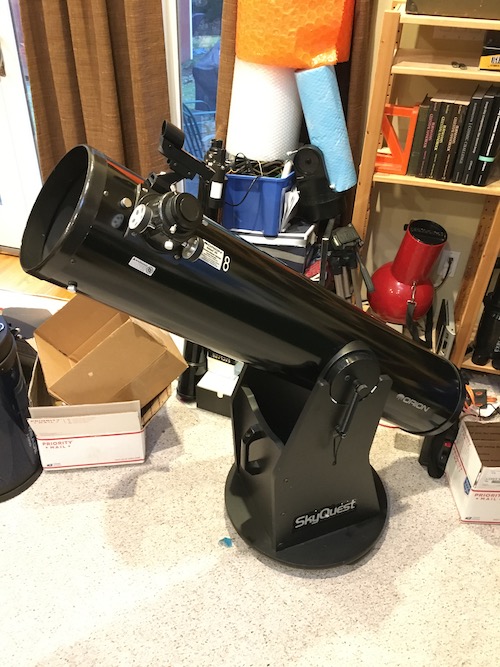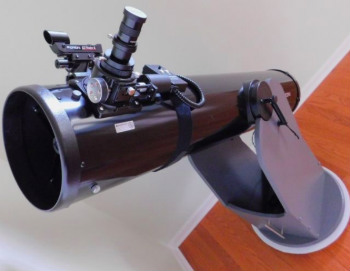The Optical Tube

The XT8 is an 8” (actually 205mm or 8.1”) f/5.9 Newtonian reflector with a focal length of 1220mm, a fairly simple design. The primary mirror is made of plate glass. Like most Newtonian reflectors, the XT8’s mirrors need to be aligned (called “collimating”) fairly often, but not every time the telescope is used. This is a relatively easy procedure and not something to be afraid of.
The focuser on the XT8 is a high-quality, single-speed 2” Crayford focuser. There is not a single plastic component to it. The newest versions of the XT8 have added a brass compression ring to the focuser and its 1.25” adapter, an improvement over the older thumb screw design, which tended to leave marks on eyepieces and accessories. The 1.25” adapter also has T threads to attach a DSLR or mirrorless camera, though this isn’t very useful given that the XT8 isn’t designed for long-exposure astrophotography and a smartphone is better for taking pictures of the Moon and planets.
The tube of the XT8 is about 48” (1.2 m) long, and as such, fits across the back seat of most vehicles.
SkyQuest XT8 Accessories
The XT8 comes with a single eyepiece – a 25mm Plossl providing 48x magnification. It’s not a bad eyepiece, but you’ll of course want additional eyepieces for higher and lower magnifications, particularly for good views of the Moon and planets. A smartphone adapter for taking simple shots of the Moon and planets is also included, and it clamps onto most 1.25” eyepieces.
The XT8’s finderscope is a simple red dot sight. A finder like this is fine for a small telescope, but with a bigger scope like the SkyQuest XT8, you might want a reflex sight like the Telrad, or a right-angle, correct-image magnifying finderscope – essentially a mini telescope itself – such as a 9×50 design.
The XT8 Mount
The SkyQuest XT8 is a Dobsonian telescope, which pivots up-down and left-right on Teflon pads. There are no locks, clutches, gears, or knobs to turn. You just push and pull the scope around the sky. Even at high magnifications, this is surprisingly easy to do, and the silky-smooth motions of the telescope make tracking and aiming the scope a breeze.

The regular XT8 uses springs for tensioning the altitude bearings, which allow the scope to pivot up and down, as the telescope is prone to tipping over if it is slightly top- or bottom-heavy, due to the small bearings providing a smaller fulcrum and any imbalance making the whole tube act like a lever. This is actually quite helpful, but the springs look a little silly and are difficult to attach and remove.
Our main gripe with the SkyQuest XT8’s mount, besides the small bearings, is the fact that it is made of particleboard. If you chip the paint/veneer you will expose what is basically pressed-together sawdust, which will quickly warp and rot. Also, particleboard is incredibly heavy — the base of the Orion SkyQuest XT8 weighs a little over 20 lbs. Thankfully, if the base is damaged or simply breaks your back, you can make a new base out of ¾” plywood for relatively little money, which will weigh less and probably look better, even with modest tools and skills. Several aftermarket vendors also offer custom new bases for your SkyQuest XT8, or indeed, any commercial Dobsonian telescope.
Should I buy a used Orion SkyQuest XT8?
The XT8 has been around for 20 years, and not much has changed – older XT8s have a slightly lower quality rack-and-pinion focuser, and the oldest units only have a 1.25” focuser, so expect to pay less for one of these. But if the mirror coatings are in good shape and the base isn’t damaged, there’s not much that can go wrong with a used unit. At worst, you can always build a new base out of plywood for a relatively low cost.
Alternative Recommendations
The Orion SkyQuest XT8 doesn’t come with a lot of accessories or features for the money compared to “deluxe” Dobsonians which hardly cost much more, but it’s a perfectly fine scope. However, here are some of our top alternative picks.
Under £600
- The Apertura AD8/Zhumell Z8/Orion SkyLine 8 includes a lot more features and accessories than the XT8, such as a 9×50 instead of a red dot finder, two eyepieces, and even a built-in dual-speed Crayford focuser and cooling fans. Upgrading the XT8 to include all of these features would cost several hundred dollars, which is a massive jump compared to the price of just getting the AD8/Z8.
- The Explore Scientific 10” Hybrid Dobsonian outperforms an 8” Dob like the XT8 by a large margin, but includes a similarly bare-bones set of accessories and features like the XT8 with the added requirements of a shroud and requiring assembly of the truss tubes before use.
- The Sky-Watcher Virtuoso GTi 150P has less light gathering or resolving power than the XT8, but comes in an ultra-compact and portable package that fits in a suitcase or backpack. The Virtuoso GTi 150P also features full GoTo and motorized tracking features, controlled with an app on your smartphone or tablet. The manual Heritage 150P is identical to the GTi 150P apart from the lack of electronics.
£600-£800
- The Apertura AD10/Zhumell Z10/Orion SkyLine 10 features the same accessories and feature upgrades as the AD8, with a dual-speed focuser and 9×50 finder being included by default along with a plethora of other accessories. The extra 2” of aperture doesn’t translate to a significant increase in weight or bulk, but will show you 56% brighter images and has 25% more resolving power.
- The Celestron StarSense Explorer 8” Dobsonian is very similar to the XT8, with the same basic set of accessories. However, the StarSense Explorer 8” has a base with cutouts to reduce weight and uses Celestron’s StarSense Explorer technology to assist in finding objects in the night sky using your smartphone piggybacked on top of a special-purpose bracket on the scope.
- The Sky-Watcher 8” FlexTube Dobsonian has the same optics as the XT8 and feature-wise is similar other than the inclusion of a 9×50 finder in lieu of a red dot and the addition of a 10mm eyepiece (120x) to the mix. The collapsible tube is its hallmark feature and allows the scope to take up slightly less storage space, at the expense of requiring a shroud and more frequent collimation. The altitude bearing design is also noticeably inferior to the XT8 or AD8.
What can you see with XT8?
The XT8 can show you a lot, especially under clear and dark skies. However, no matter where you are, the Moon and planets will be fabulous. Tiny lunar details just a few miles across, like craters, ridges, and volcanoes known as lunar domes, can be seen on a steady night, as can the phases of Mercury and Venus. On Mars, the XT8 will show up to a dozen or so features to the trained eye when Mars is close to Earth. Jupiter’s cloud bands show lots of festoons and swirls. The Galilean moons of Jupiter are no longer mere pinpoints but tiny disks, with hints of color. Saturn shows several moons and intricate cloud bands, along with the Cassini and possibly Encke divisions. Uranus and Neptune are merely bluish-green dots, though you might be able to spot Neptune’s largest moon, Triton.
The quality of many deep-sky objects you view with the SkyQuest XT8, or any telescope, will be heavily dependent on the light pollution you live under. Galaxies under dark skies look fabulous with the XT8 – you’ll have no trouble spotting the spiral arms of M51 and M33, the H-II regions of M82 and M101, and all sorts of dust lanes and details in several hundred of the brightest galaxies. But under light-polluted skies, the f


